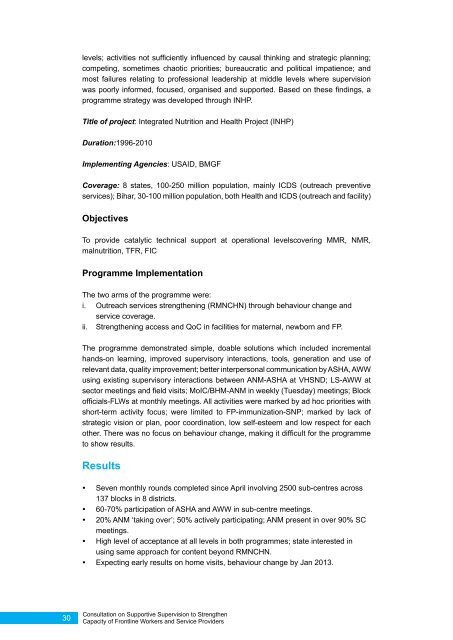Download the complete report - Unicef
Download the complete report - Unicef
Download the complete report - Unicef
Create successful ePaper yourself
Turn your PDF publications into a flip-book with our unique Google optimized e-Paper software.
levels; activities not sufficiently influenced by causal thinking and strategic planning;<br />
competing, sometimes chaotic priorities; bureaucratic and political impatience; and<br />
most failures relating to professional leadership at middle levels where supervision<br />
was poorly informed, focused, organised and supported. Based on <strong>the</strong>se findings, a<br />
programme strategy was developed through INHP.<br />
Title of project: Integrated Nutrition and Health Project (INHP)<br />
Duration:1996-2010<br />
Implementing Agencies: USAID, BMGF<br />
Coverage: 8 states, 100-250 million population, mainly ICDS (outreach preventive<br />
services); Bihar, 30-100 million population, both Health and ICDS (outreach and facility)<br />
Objectives<br />
To provide catalytic technical support at operational levelscovering MMR, NMR,<br />
malnutrition, TFR, FIC<br />
Programme Implementation<br />
The two arms of <strong>the</strong> programme were:<br />
i. Outreach services streng<strong>the</strong>ning (RMNCHN) through behaviour change and<br />
service coverage.<br />
ii. Streng<strong>the</strong>ning access and QoC in facilities for maternal, newborn and FP.<br />
The programme demonstrated simple, doable solutions which included incremental<br />
hands-on learning, improved supervisory interactions, tools, generation and use of<br />
relevant data, quality improvement; better interpersonal communication by ASHA, AWW<br />
using existing supervisory interactions between ANM-ASHA at VHSND; LS-AWW at<br />
sector meetings and field visits; MoIC/BHM-ANM in weekly (Tuesday) meetings; Block<br />
officials-FLWs at monthly meetings. All activities were marked by ad hoc priorities with<br />
short-term activity focus; were limited to FP-immunization-SNP; marked by lack of<br />
strategic vision or plan, poor coordination, low self-esteem and low respect for each<br />
o<strong>the</strong>r. There was no focus on behaviour change, making it difficult for <strong>the</strong> programme<br />
to show results.<br />
Results<br />
• y Seven monthly rounds <strong>complete</strong>d since April involving 2500 sub-centres across<br />
137 blocks in 8 districts.<br />
• y 60-70% participation of ASHA and AWW in sub-centre meetings.<br />
• y 20% ANM ‘taking over’; 50% actively participating; ANM present in over 90% SC<br />
meetings.<br />
• y High level of acceptance at all levels in both programmes; state interested in<br />
using same approach for content beyond RMNCHN.<br />
• y Expecting early results on home visits, behaviour change by Jan 2013.<br />
30<br />
Consultation on Supportive Supervision to Streng<strong>the</strong>n<br />
Capacity of Frontline Workers and Service Providers

















